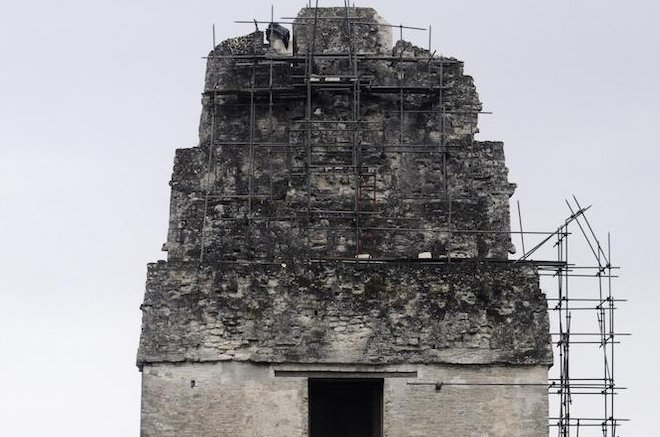
An exterior view of the Great Jaguar, main building of Tikal, the most important city of the ancient Maya civilization at the province of Peten, Feb. 28, 2011. Tikal was one of the main cultural centers of the Maya civilization. The oldest known fragments of the Maya calendar were found in San Bartolo, Guatemala.
Photo by Sandra Sebastian/EPA
April 14 (UPI) -- The oldest evidence of the Maya calendar has been excavated at San Bartolo, Guatemala, found among fragments of painted murals.
Acording to a new study, two fragments with a "7 deer" date notation date to between 300 and 200 BCE, based on radiocarbon dating.
Authors of the study said that the finding "represents a day in the 260-day divinatory calendar used throughout Mesoamerica and among indigenous Maya communities today."
"It's the one calendar that survives all the conquests and the civil war in Guatemala," the latter of which was waged from 1960 to 1996, study first author David Stuart told Live Science.
"The Maya of today in many communities have kept it as a way of connecting to their ideas of fate and how people relate to the world around them. It's not a revival. It's actually a preservation of the calendar," said Stuart, the Schele professor of Mesoamerican art and writing at the University of Texas at Austin.
Stuart was part of the team that discovered the San Bartolo site in 2001.
The 7 Deer day record represents the earliest securely dated example of the Maya calendar, according to the study.
The previous oldest known evidence of the Maya calendar also came from San Bartolo. the new discovery pre-dates that one by 150 years.
The fragments from the Maya calendar came from an architectural complex known as the Las Pinturas pyramid.
It consists of a pyramid with seven construction phases and several auxiliary structures.
The researchers say the fragments indicate it is a record in the Mesoamerican 260-day calendar, "7 Deer," or, in the colonial Maya system of 16th century Yucatán, "7 Manik."
The 260-day count is the traditional divination calendar used throughout ancient Mesoamerica, surviving up to the present day among some indigenous communities in southern Mexico and Guatemala, according to the study.
Until these fragments were discovered all early Maya calendar records came from stone monuments.
April 14 (UPI) -- The oldest evidence of the Maya calendar has been excavated at San Bartolo, Guatemala, found among fragments of painted murals.
Acording to a new study, two fragments with a "7 deer" date notation date to between 300 and 200 BCE, based on radiocarbon dating.
Authors of the study said that the finding "represents a day in the 260-day divinatory calendar used throughout Mesoamerica and among indigenous Maya communities today."
"It's the one calendar that survives all the conquests and the civil war in Guatemala," the latter of which was waged from 1960 to 1996, study first author David Stuart told Live Science.
"The Maya of today in many communities have kept it as a way of connecting to their ideas of fate and how people relate to the world around them. It's not a revival. It's actually a preservation of the calendar," said Stuart, the Schele professor of Mesoamerican art and writing at the University of Texas at Austin.
Stuart was part of the team that discovered the San Bartolo site in 2001.
The 7 Deer day record represents the earliest securely dated example of the Maya calendar, according to the study.
The previous oldest known evidence of the Maya calendar also came from San Bartolo. the new discovery pre-dates that one by 150 years.
The fragments from the Maya calendar came from an architectural complex known as the Las Pinturas pyramid.
It consists of a pyramid with seven construction phases and several auxiliary structures.
The researchers say the fragments indicate it is a record in the Mesoamerican 260-day calendar, "7 Deer," or, in the colonial Maya system of 16th century Yucatán, "7 Manik."
The 260-day count is the traditional divination calendar used throughout ancient Mesoamerica, surviving up to the present day among some indigenous communities in southern Mexico and Guatemala, according to the study.
Until these fragments were discovered all early Maya calendar records came from stone monuments.
No comments:
Post a Comment